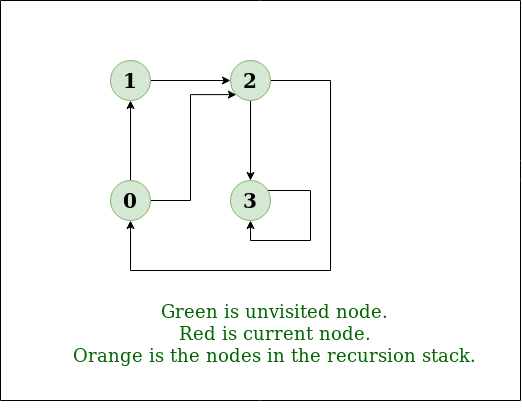Cycle Detection in Graphs
Every graph without a cycle is a Tree. If a graph contains a cycle then we have a way to visit node more than one time.

Cycle Detection in Undirected Graphs :
An Undirected Graph contains a cycle if next node is already visited and next node is not parent node of current node.
Using Depth-First Search (DFS) :
#include <bits/stdc++.h>
using namespace std;
class Graph {
int V;
list<int> *l;
public:
Graph(int v) {
V = v;
l = new list<int>[V];
}
void addEdge(int i, int j, bool undir = true) {
l[i].push_back(j);
if (undir) l[j].push_back(i);
}
bool dfs(int node, vector<bool> &visited, int parent) {
// mark that node visited
visited[node] = true;
for (auto nbr : l[node]) {
if (!visited[nbr]) {
bool foundACycle = dfs(nbr, visited, node);
if (foundACycle) return true;
} else if (nbr != parent)
return true;
}
return false;
}
bool contains_cycle() {
// graph is a single component
vector<bool> visited(V, false);
return dfs(0, visited, -1);
}
};
int main() {
Graph g(6);
g.addEdge(0, 1);
g.addEdge(0, 4);
g.addEdge(2, 1);
g.addEdge(3, 4);
g.addEdge(4, 5);
g.addEdge(2, 3);
g.addEdge(3, 5);
cout << g.contains_cycle(); // 1
return 0;
}
Cycle Detection in Directed Graph :
In Directed Graph we store both visited nodes and nodes of current path (using stack). If next node is visited and also in current path then the graph contains a cycle.

#include <bits/stdc++.h>
using namespace std;
class Graph {
int V;
list<int> *l;
public:
Graph(int v) {
V = v;
l = new list<int>[V];
}
void addEdge(int i, int j, bool undir = false) {
l[i].push_back(j);
if (undir) l[j].push_back(i);
}
bool dfs(int node, vector<bool> &visited, vector<bool> &stack) {
// return true if backedge is found, else return false
// arrive at node
visited[node] = true;
stack[node] = true;
for (int nbr : l[node]) {
if (stack[nbr])
return true;
else if (!visited[nbr]) {
bool nbrFoundACycle = dfs(nbr, visited, stack);
if (nbrFoundACycle) return true;
}
}
// going back
stack[node] = false;
return false;
}
bool contains_cycle() {
vector<bool> visited(V, false);
vector<bool> stack(V, false);
for (int i = 0; i < V; i++) {
int source = i;
if (!visited[source]) {
if (dfs(source, visited, stack)) return true;
}
}
return false;
}
};
int main() {
Graph g1(3);
g1.addEdge(0, 1);
g1.addEdge(1, 2);
g1.addEdge(2, 0);
cout << g1.contains_cycle() << "\n"; //1
Graph g2(3);
g2.addEdge(0, 1);
g2.addEdge(1, 2);
cout << g2.contains_cycle() << "\n"; //0
return 0;
}
Bipartite Graph :

Bipartite graphs may be characterized in several different ways:
- A graph is bipartite if and only if it does not contain an odd cycle.
- A graph is bipartite if and only if it is 2-colorable, (i.e. its chromatic number is less than or equal to 2).
- Any bipartite graph consisting of n vertices can have at most n^{2}/4 edges.
- The spectrum of a graph is symmetric if and only if it is a bipartite graph.

#include <bits/stdc++.h>
using namespace std;
class Graph {
int V;
list<int> *l;
public:
Graph(int v) {
V = v;
l = new list<int>[V];
}
void addEdge(int i, int j, bool undir = true) {
l[i].push_back(j);
if (undir) l[j].push_back(i);
}
bool dfsHelper(int node, int *visited, int parent, int color) {
visited[node] = color;
for (auto nbr : l[node]) {
if (visited[nbr] == 0) {
int subProblem = dfsHelper(nbr, visited, node, 3 - color);
if (!subProblem) return false;
} else if (nbr != parent and color == visited[nbr]) {
return false;
}
}
return true;
}
bool isBipartite() {
int visited[V] = {0};
int color = 1;
return dfsHelper(0, visited, -1, color);
}
};
int main() {
// by coloring nodes at each step
// if current node has color 1
// then adjacent on should have color 2
Graph g1(3);
g1.addEdge(0, 1);
g1.addEdge(1, 2);
g1.addEdge(2, 0);
cout << g1.isBipartite() << "\n"; //0
Graph g2(4);
g2.addEdge(0, 1);
g2.addEdge(1, 2);
g2.addEdge(2, 3);
g2.addEdge(3, 0);
cout << g2.isBipartite() << "\n"; //1
return 0;
}